FLOATING WORLD CULTURE
Week 3 Class Notes, 14 February 2019
The Yoshiwara
Samurai Women
Samurai women were expected to exhibit the same traits as the men: loyalty and honour, self-control and dignity, devotion to duty and self-sacrifice. Their primary functions were to become wives: to run their husband’s household and to have children. They might also serve as ladies-in-waiting in high-ranking samurai households, such as those of daimyo or the shogun. High-ranking samurai women would be trained in arts such as calligraphy, poetry, music (especially the koto) and flower arrangement.

The Birth of a Young Lord, by Ikuhide, 1889
Samurai women were expected to be able to defend themselves and might receive some martial arts training. They were not expected to become warriors, but in some rare instances women chose to fight alongside the men. There were a couple of famous examples of women fighters in the Genpei War (1180-1185), the civil war between the Taira and Minamoto.
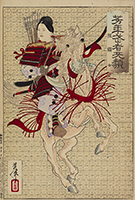
Hangaku Gozen, by Yoshitosi, 1886
Hangaku Gozen fought on the side of the Taira in the war. The Minamoto were victorious and established the Kamakura Shogunate in 1192 and in 1201 she participated in an attempt to overthrow the new government. She led a platoon of 3000 men and was said to have used a naginata in battle.
Tomoe Gozen was married to Minamoto no Yoshinaka and also fought in the Genpei War. She was known for her skill as an archer and is best remembered for her courage at the Battle of Aqazu in 1184.
Women were not expected to fight in battle, but during times of war the men were often away and women were expected to defend the home.

Tomita Nobutaka and his wife Yuki no Kata, by Yoshitoshi, 1885
During the Edo Period, a time of peace, the ladies-in-waiting at the Shogun’s Palace trained in the use of swords and naginata.

Ladies in Waiting of the Chiyoda Palace: Sword and Pole Practice
by Chikanobu, 1895
From the collection of the Metropolitan Museum of Art
There was a specially trained unit of female samurai soldiers who guarded the women’s quarters of the Shogun’s castle.

Otachi Shinzoke (Spear Defence), the Inner Precincts at Chiyoda Castle
by Chikanobu, 1896
From the collection of the Metropolitan Museum of Art
The end of the Edo Period was a time of great political turmoil that continued into the Meiji Period (1868-1912). A revolt against policies of the new Meiji government was led by samurai of the Satsuma domain (called the Satsuma Rebelllion) in 1877 and women were said to have fought in battle in defence of the city of Kagoshima.

A Chronicle of the Subjugation of Kagoshima in Sasshu (Satsuma), by Yoshitoshi, 1877
Licensed Brothel Districts
When talking about the sex trade in Japan we use the terms courtesans and prostitutes. “Courtesans” refer to women who are educated and refined and who provide services beyond basic sexual gratification. They would cater to a more exclusive clientele than common prostitutes.
In 1589 one of Hideyoshi’s retainers was given permission to open a brothel in Kyoto. He built a walled-in brothel district in the Nijo Yanagimachi area. This district was very successful and its most talented and most desirable women came to be called tayu, a term which at the time referred to the principle performers in a dance or drama. Later in 1640-41 it moved to the suburb of Suzakuno where it became known as the Shimabara District.
A licenced district called the Yoshiwara, modeled on the first one in Kyoto, opened in Edo in 1617. Soon each major city had its licensed pleasure quarter, or brothel area, that was separated from the rest of the city by a wall or moat, but the Yoshiwara was to become the most famous of all.
At the beginning of the Edo Period there were many samurai families who had fallen on hard times if they had served daimyo who had not supported Tokugawa Ieyasu at the Battle of Sekigahara. Some of these families survived by opening brothels, or by selling women to brothels. Many women who had belonged to high-ranking samurai households and were well educated and trained in the arts became tayu, raising the bar for the requirements, in terms of sophistication and cultural accomplishments, of this rank of prostitute. Tayu required assets beyond beauty, such as poise, wit, impeccable manners, the ability to charm and entertain guests, and skill in arts traditionally associated with upper class such as flower arrangement, calligraphy, poetry composition, and musical training.
The Yoshiwara
From the beginning of the Edo Period, when Tokugawa Ieyasu began construction on his massive castle complex in Edo, the city had a sex ratio problem. This was due to the high percentage of samurai in the city (mostly single men) and the large influx of constructions workers needed to build the castle and then the mansions for the daimyo, who were required, according to the system of alternate attendance, to live in Edo 50% of the time, along with a large retinue of their samurai retainers. Men outnumbered women by at least 2:1. Prostitution, though generally disapproved of, was considered a necessity.
A group of prominent Edo brothel owners met and agreed to ask the government for the exclusive right to operate brothels in a restricted area. Permission was given and in 1617 land was allocated. The Yoshiwara, modeled on the first walled district in Kyoto, opened at the end of 1618. It was beside the river and had a moat around it. There was only one entrance gate.
This system was advantageous to the brothel owners because it gave them a monopoly.
It was advantageous to the government because it made it easier to keep track of suspicious individuals who were suspected of hiding out in brothels (mostly samurai made ronin by the downfall of their previous lords) as the rules for the new district forbade clients from staying there for more than 24 hours and also required proprietors to report suspicious individuals. Furthermore it facilitated taxation.
Also, in theory, limiting the number of illegal brothels would help to protect the workers and prevent young girls from being kidnapped and sold illegally into prostitution. In reality illegal brothels continued.
There were a higher percentage of the highest ranking courtesans, or tayu, in the early decades of the 17th century than at any subsequent time. Their customers consisted mostly of samurai, including daimyo, and a few wealthy merchants and wealthy out-of-town visitors. Ironically, while the courtesans themselves were ranked, the social standing of their customers was not so important as their ability and willingness to pay. One of the special features of the Yoshiwara was that the traditional class distinctions didn’t matter there and the Yoshiwara became a place where commoners could mingle with samurai on a more-or-less equal footing.
Men of all classes had to surrender their swords before entering any Yoshiwara establishment. This rule was to prevent disputes from becoming too violent and to prevent the prostitutes from having access to a weapon with which they might commit suicide.
In 1656 the government informed the Yoshiwara proprietors that they were to move to a location further from the city center and a location outside the city, in Asakusa, was chosen. At the beginning of 1657, before the move had been completed, a terrible fire, known as the Great Meireki Fire, broke out and spread through the city. Most of the city was destroyed. The population was then close to one million and 107,406 people died.
The Shin Yoshiwara (New Yoshiwara) was larger than the original, covering an area of approximately 20 acres, but otherwise was much like it. It was about 5 km from the castle gate to the Yoshiwara entrance as the crow flies, but the actual journey through the city would have been almost twice as long, about a 2 hour walk from the city center. Many preferred to travel by boat up the Sumida River. The Yoshiwara was surrounded by water and there was only one entrance. Visitors approached along the Nihon Embankment, originally built for flood control.

Nihon Embankment, by Hiroshige, 1857
There were more than 100 tea houses along the 800 yard stretch of the embankment that led to the Yoshiwara. Each tea house was associated with a particular brothel and they would function as middlemen – introducing customers to the brothels, making specific arrangements, and entertaining customers while they waited. The nicest tea houses associated with the best brothels were inside the Yoshiwara. The willow at the end of the embankment was called the “Looking Back Willow” as it was at the top of the slope leading down to the main gate of the quarter, where customers would turn to look back as they headed home.
For the uninitiated or the out-of-towner there were guide-books to the Yoshiwara. One well-known one was by Hishikawa Moronobu, 1678, titled A Guide to Love in the Yoshiwara.

Street Scene in the Yoshiwara, by Hishikawa Moronobu, c.1880
From the collection of the Metropolitan Museum of Art
If a visitor to the Yoshiwara wanted to engage the services of a lower grade prostitute he could make an arrangement ahead of time through a teahouse or go directly to the brothel. The highest ranked courtesans did not work out of their brothels, rather they met their clients at an ageya, a house of assignation. These were beautifully furnished places complete with lovely gardens. If a man wished to engage the services of one of these ladies he first needed an introduction to the ageya (he had to provide a reference). When he arrived at the ageya and requested a meeting with a particular courtesan they would send for her and then he would be expected to order food and sake for himself and any friends who had accompanied him and to hire entertainers to amuse them until the lady arrived. The courtesan would parade, slowly, through the street with her entourage enroute to the ageya. She would be accompanied by a female supervisor or chaperone called a yarite, 1 or 2 child attendants called kamuro, 1 or 2 teen-age apprentices called Shinzo, and a male attendant (the men and older women were not often shown in the ukiyo-e prints). When she arrived at the ageya she and the client would enact a simplified marriage ceremony, at which point she could reject him if she chose (though it was rude to do so in front of others). Usually they would retire to her room where she would then reject him. When he visited again he would be rejected again. The highest ranked courtesans did not have sex with clients until the 3rd visit.
These visits were extremely expensive. Not only did the customer have to pay for the courtesan and the services provided by the ageya, but he was expected to tip everyone involved (staff of the ageya, members of her entourage, etc.). It is estimated that the cost of one of these visits would be the equivalent of $4000 today. All financial transactions were handled through the ageya or the teahouse where one made the initial arrangements.
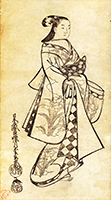
Courtesan, by Kaigetsudo Anchi, c.1714
The courtesans also had high expenses. They were indebted to their brothels for their training and upkeep, they had to pay for their own clothing as well as that of their assistants, and they were also expected to tip other Yoshiwara employees.
There were a range of grades of prostitutes and brothels within the Yoshiwara with the cheapest being alongside the moat. The cost of the highest ranked women was about 40 times the cheapest. The highest classes stayed inside unless they were on parade or meeting a prospective client. The middle and lower ranks of prostitutes sat on display behind a lattice, though the lower ranks might also be out on the street actively soliciting customers. In theory women had to be 18 (17) to become prostitutes in the Yoshiwara. In reality some were as young as 14 (13).

Mid-rank prostitutes on display
c. mid 19th century
A courtesan’s rank was determined by an association of experienced Yoshiwara residents including ageya proprietors, tea house proprietors, and veteran yarite. Women were rated according to their beauty, intelligence, cultural refinement, deportment and earning power. Tayu were never to be vulgar, never to touch money, and never to eat in front of a client. Another popular name for the highest ranked courtesans was keisei, meaning castle-toppler.

Perspective Picture of the Great Gate and Naka-no-cho in the Shin Yoshiwara
by Masanobu, c.1740s
The entrance gate was always guarded. Guards were looking out for suspicious individuals entering the quarter, but mostly they were there to prevent women from escaping, or men from departing before they had paid their bill. In the early days of the Yoshiwara, until 1640, courtesans were free to leave the quarter and were often summoned to visit high ranking officials. Later all female residents had to have permits to leave.
Up to the 1660s and 70s the clientele still consisted mostly of samurai, rich merchants and prosperous farmers. Over time the government had begun to disapprove of samurai visiting brothels and many wore large hats to hide their identities. In 1693 and again in 1735 daimyo were banned from visiting the Yoshiwara. Because of this and ongoing competition from illegal establishments and independent streetwalkers, the Yoshiwara sought a wider customer base during the 1700s. Festivals were introduced to attract more customers.
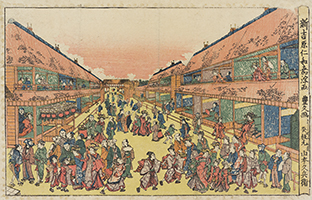
Niwaka Festival at Shin Yoshiwara Pleasure District in Perspective Picture
by Toyohisa, c.1810
One of the oldest and most famous festivals was the Cherry Blossom Festival. Cherry trees about to bloom were brought to the Yoshiwara and placed down the center of the main street. High ranking courtesans and their attendants would walk down the avenue in a stately parade to view the cherry blossoms, and in turn to be watched and admired by the visitors to the district. Prostitutes are always compared to cherry blossoms in Japanese art and literature. They both are very beautiful, but their beauty only lasts a short time. The cherry tree just inside the gate was known as the cherry tree of first meeting.
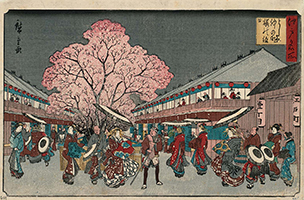
Holiday of Cherry Blossoms at Naka-no-cho in the Yoshiwara
by Hiroshige c. 1850
From the collection of the Boston Museum of Fine Arts
The Yoshiwara was essentially a town unto itself. Many people lived their entire lives there. In addition to approximately 3000 prostitutes the brothels (called houses) were home to managers and servants. Better houses would have child attendants called kamuro and teenage trainees called shinzo. The area also housed tea house workers, cooks, entertainers, masseurs, hairdressers, and people providing a whole range of other services.
In the early 1700s the highest class of courtesan called tayu disappeared and was replaced by a class called oiran. This change reflected a change in the nature of the experience of the Yoshiwara itself. Tayu met their customers at an expensive ageya and a good part of the customer’s motivation was to show off his wealth and generosity. The ageya disappeared along with the tayu, and oiran met their customers at tea houses (customers still required an introduction and they still did not engage in sex until the third meeting). A particular dialect and slang unique to the district had developed and this, mixed with the elaborate set of rules and rituals of the Yoshiwara, posed a challenge for newcomers. A sophisticated man-about-town would know how to conduct himself in the pleasure district and how to engage in banter with its inhabitants. His familiarity with the district secured his reputation as a dandy and men now visited oiran to show off both their wealth and style. It was a status symbol to be a client of a famous oiran.
Visits to tayu and oiran were never really about sex. They were almost theatrical experiences where the customer was wined and dined, pampered, flattered and entertained in opulent surroundings, and where the courtesan became a sort of living work of art. The company of the highest ranked women was well beyond the reach of most men. They would have to be content with glimpsing these women as they paraded through the Yoshiwara, or they could buy ukiyo-e prints of them.
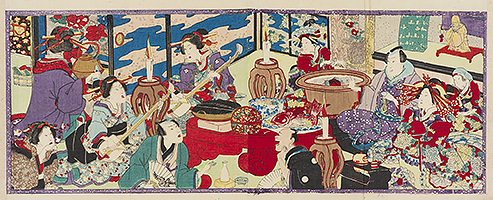
Musical party and banquet in the Yoshiwara, c.1860s
The tayu and oiran represented a feminine ideal and became the most famous female celebrities of the time, but they were also tragic, romantic figures. It was understood that their beauty would fade and their careers would be short. Tragic stories of courtesans were common in popular literature and theatre. In stories they usually died for their lover, of with their lover. In reality lives of prostitutes, particularly those not of the highest status, were miserable and often shortened by disease. Their best hope was that a wealthy customer would care enough to buy out their contract with the brothel and rescue them from the profession, but this rarely happened. Suicides with lovers, however, did occur.
Courtesans were taught how to make their clients fall in love with them, but they were instructed never to fall in love themselves. A courtesan’s professional life depended on how much money a client spent on her. The fee for her services went to the brothel, so the money for her personal expenses (clothes, bedding, attendants, etc.) all had to come from the gifts he gave her.
Naturally, many of the young women did fall in love. Some men delighted in having prostitutes fall in love with them and collected tokens of their affection including letters, locks of hair, and even finger nails and tips of fingers which the women would cut off as proof of their love. Another way in which prostitutes proved their love was to have a tattoo of the client’s name, usually on an arm. Top Yoshiwara courtesans were expected to be able to write passionate love letters, but that was all as they had to be physically perfect and unblemished.
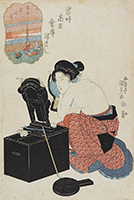
The Asadaya Restaurant in Namiki (a prostitute with a name tattooed on her arm)
by Kunisada, c.1820
Courtesan Fashion
Prostitutes were required by law to tie their obi at the front. All other classes of women tied their obi (the sash around the waist) at the back. Ordinary women would gather the excess material of their kimono up around the waist, where it was secured under the obi. Courtesans let the excess material flow behind them in the manner of aristocratic women, or they held it up when they went outside. Many classes of people, including courtesans, wore platform shoes called geta, useful for keeping feet out of the rain or snow. Over time the geta worn by courtesans became excessively high.
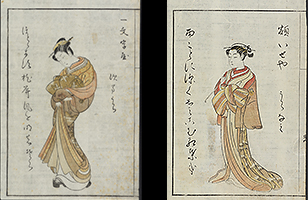
Courtesans, by Harunobu, 1770
For many years courtesans were expected to do their own hair, as did other women. In those days courtesans were considered fashion icons and other women often copied their styles.
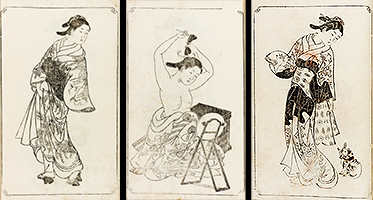
A courtesan, a woman doing her hair, and a townswoman with a cat
From Picture Book of Mount Asaka
by Sukenobu, 1739
Hairstyles changed somewhat over time, but not drastically. Not, that is, until the late 1770s when a new professional emerged: the female hairdresser. After that courtesans had their hair dressed by experts and styles became more extravagant. Hairdos became bigger and more pins and combs were added.
By the early 1800s both hair and makeup were becoming more extreme. It had always been the fashion for Yoshiwara courtesans to blacken their teeth, as did married women. Now they also added a green colour to the lower lip, a fashion taken up by some other women too.
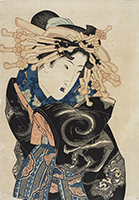
Courtesan (top half of a vertical diptych)
by Eisen, c.1830
Please note the lower lip should be green, but the colour has faded to blue.
Note: The material used to blacken teeth was called ohaguro. A description is given in The Sexual Life of Japan by J.E. de Becker, published by the American Anthropological Society in 1899. He describes ohaguro as a dye made by immersing heated iron scrapes in water and adding a small quantity of sake. It was then mixed with powdered gall-nuts. De Becker’s book is still available under the title The Nightless City or the History of the Yoshiwara Yukwaku. It is meant as an academic study, so maybe not the best read, but if the subject interests you it is fascinating. He describes the Yoshiwara at the end of the 19th century, but much of what he writes is applicable to the Edo period as well.
Courtesan’s clothing also became more extreme in the 19th century. They began adding padding to the hems of their kimono to make them stand out more and appear fuller and the obi became larger.
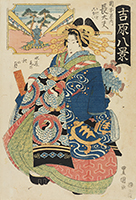
Choto, by Toyokuni II, c.1830
Geisha
In the 1600s the term geisha (meaning skilled person) applied to men who entertained at parties in the licensed districts. Female entertainers started to appear in these roles around the middle of the 18th century. By 1780 female geisha outnumbered males. By 1800 the term now applied specifically to female entertainers or males who had received special training to become geisha.
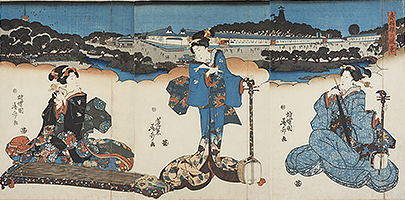
Three Geisha at Akebane, by Shunsho, c. early 1840s
Geisha entertained at parties in the Yoshiwara, but they were prohibited by law from selling sex and this rule seems to have been followed in the Yoshiwara, though not necessarily so elsewhere. They were also prohibited from wearing the sort of ostentatious clothing and elaborate hairstyles that had become the trademark of courtesans.
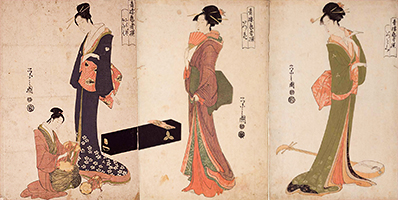
Ohane and Ofuku, Itsuhana, and Itsutomi, from Selected Geisha of the Yoshiwara
by Eishi, c.1794-95
From the collection of the Tokyo National Museum
Geisha were not restricted to the Yoshiwara. They could be hired to perform at any party and the rise in popularity of female geisha in the later 1700s coincided with the increase in numbers of fancy restaurants in Edo. Their trademark instrument was the three-stringed shamisen.
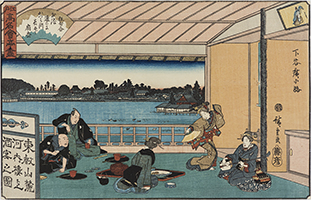
The Kawachiro Restaurant at Shitaya Hirokoi
by Hiroshige, c.1835-42
(showing one geisha dancing and one geisha playing the shamisen)
By the 19th century geisha had become the new icons of feminine beauty and accomplishment. Their more conservative styles set the new fashion trends and were being copied by other women.
Comparison of picture of a geisha and of a courtesan
both by Eisen, both c.1830
Ukiyo-e prints picturing women are often supposed to be portraits of particular beauties, but they are not accurate portraits. Rather they always reflect the ideal of female beauty: a small mouth, widely spaced eyes, and a straight nose.
Wakashu
Every Japanese male who had reached puberty, but who was not yet considered to be a man, was a wakashu. Little had been published about this stage of life until the ROM presented a ground-breaking exhibition three years ago called A Third Gender all about wakashu. Their principle theme was an exploration of the sexuality of wakashu, who were considered acceptable and desirable sexual partners for both men and women. This is not to say that young men who were wakashu were necessarily sexually active -- most weren’t -- but they could be.
In artwork Wakashu can be distinguished from adult men by their distinctive hairstyle. It was the custom for all adult men to shave the tops of their heads. Wakashu shaved a patch on top, but left a forelock at the front.
Some wakashu worked as prostitutes. Sex between an adult man and a wakashu was not considered a homosexual act since wakashu were not men, but rather in a period of ambiguous sexuality, a “third gender”, according to the scholars who’s work the ROM’s exhibit was based on.
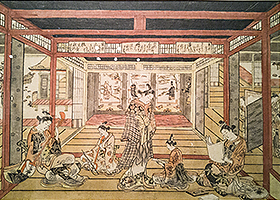
Perspective Picture Triptych of “The Three Evening Poems” (a wakashu in the center)
By Masanobu, c.1742-44
From the collection of the ROM
Wakashu also appear in art from the Edo Period in non-sexual or non-romantic contexts. It was simply a stage of life that all males passed through. The length of time that one remained a wakashu depended on a various factors such as the family’s social and financial position.









